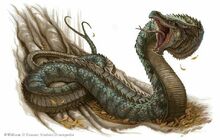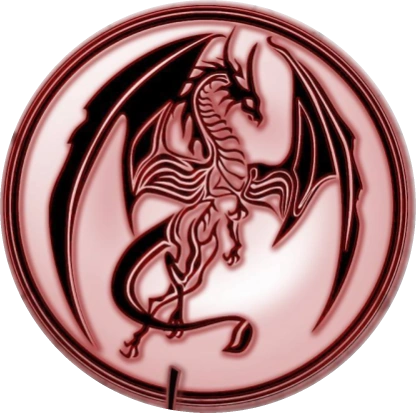No edit summary Tag: Source edit |
No edit summary Tag: Visual edit |
||
| (9 intermediate revisions by 4 users not shown) | |||
| Line 1: | Line 1: | ||
| + | {{Stub}} |
||
| − | [[File:C35d2456e3197272474f01d1f0c70a5a.jpg|thumb|220x220px]] |
+ | [[File:C35d2456e3197272474f01d1f0c70a5a.jpg|thumb|220x220px|Artwork of a wyrm from William O'Connor's ''Dracopedia'']] |
| + | Wyrms (alternatively wurms, worms or orms) are serpentine dragons, normally of European origins. The word (derived from the Norse 'ormr') used to mean all dragons (or all dragons known in Europe/European dragons), but in modern use it is reserved for dragons with 'wormlike' qualities: a long body shape which is either legless or with small legs. |
||
| − | '''Wyrms'', occasionally spelled '''Wurms''' or '''Worms''', are a legless and wingless species found inhabiting waters, typically oceans but sometimes large rivers and lakes as well. They bear a resemblance to the [[Knucker (Dragonology)|Knucker]]. The most well-known example of Wyrms in folklore is the [[Lambton Worm]]. According to legend, if the Wyrm was cut into pieces, it would simply grow back together and reattach itself. Only when John Lambton covered himself with spear-spiked armor, which the Wyrm sliced itself to pieces attempt to grapple with, and feel into the river, washing away before it could reconnect. |
||
| + | |||
| + | Wyrms in Britain include the [[Lambton Worm]] and the Laidly Worm of Bambrough, as well as many more wyrm legends that go by other names: in Sussex, deep pools in the ground are inhabited by wyrms called [[Knucker (Mythology)|knuckers]]. In Wales, the wyrms are called anfanc, and in Scotland they may be called beithir. |
||
| + | |||
| + | 'Wurm' is one of the root words for [[LindWurms (Dragon Species)|lindwurm]] or lindorm, which are dragons found in western and northern Europe: the Bride of the Lindorm King is a popular folktale. The dragon [[Fafnir]] is often described as a lindorm. Historically, 'lindorm' could mean 'all dragons', then 'all serpentine dragons', but in modern use it refers to 'serpentine dragons with two legs' or 'wingless wyverns'. |
||
[[de:Draconidae_(Spiderwick)]] |
[[de:Draconidae_(Spiderwick)]] |
||
[[Category:Mythology]] |
[[Category:Mythology]] |
||
[[Category:Dragon Species]] |
[[Category:Dragon Species]] |
||
| + | [[Category:Wyrms]] |
||
| + | [[Category:Mythological Animals]] |
||
Revision as of 19:44, 11 October 2021

Artwork of a wyrm from William O'Connor's Dracopedia
Wyrms (alternatively wurms, worms or orms) are serpentine dragons, normally of European origins. The word (derived from the Norse 'ormr') used to mean all dragons (or all dragons known in Europe/European dragons), but in modern use it is reserved for dragons with 'wormlike' qualities: a long body shape which is either legless or with small legs.
Wyrms in Britain include the Lambton Worm and the Laidly Worm of Bambrough, as well as many more wyrm legends that go by other names: in Sussex, deep pools in the ground are inhabited by wyrms called knuckers. In Wales, the wyrms are called anfanc, and in Scotland they may be called beithir.
'Wurm' is one of the root words for lindwurm or lindorm, which are dragons found in western and northern Europe: the Bride of the Lindorm King is a popular folktale. The dragon Fafnir is often described as a lindorm. Historically, 'lindorm' could mean 'all dragons', then 'all serpentine dragons', but in modern use it refers to 'serpentine dragons with two legs' or 'wingless wyverns'.
